Carme Ruscalleda cooks at home as well as at Sant Pau, her three-Michelin-star restaurant in Sant Pol de Mar, near Barcelona. One of her tricks is to make the sofrito beforehand and freeze it, following a series of steps to make sure it turns out as the perfect base for all kinds of dishes. Here’s how:
1. Think ahead and make enough sofrito to store in the freezer.
At home I’ve always got some onion I’ve fried in olive oil for many, many hours. I slice up some onions and when they’re done I put them in a bag and freeze them. I do the same with tomato, again cooking it for a long time until it caramelises, although I obviously don’t fry it for as long as the onion. The same goes for sweet and hot peppers—bag it and freeze it.
2. Always fry each ingredient separately.
I always fry each ingredient separately because I can always mix them together later. If I freeze a traditional sofrito of onion, tomato, pepper and a bit of garlic, then it will always taste the same. But if I freeze all the ingredients separately, when I come to make it I can opt to leave out the onion or the tomato… So my noodles, rice and potatoes will always come out differently every time and it will never be a case of “more of the same”.
3. Use the best-quality olive oil possible.
Suppose one day I decide to make some noodles, for example, and I add some onion and tomato, or onion and pepper. If I’ve fried them in good-quality olive oil I know I’ll get a perfect sofrito and they’ll be preserved for longer.
4. Use mineral water.
Mineral water helps everything cook faster. But that’s not the only reason to use mineral water. Never use tap water. You shouldn’t use tap water for cooking or making tea or coffee. I have very hard water where I live and it destroys whatever I cook. Water purity is very important.
5. Take your time. A good sofrito takes time.
A good sofrito calls for caramelised onions, tomatoes and/or peppers and that takes time, especially when there are onions involved. Time is key—you could probably watch a film or two in the meantime. An hour spent caramelising onion is an hour well spent.
6. Calculate how many onions you’ll need; don’t forget they reduce a lot.
Onion shrinks in volume as it loses its water. 1 kg of raw onion will give you 100 g of caramelised onion—just its true essence.
7. You need to be on hand to stir.
As with anything you’re cooking on a hob, you should never leave a sofrito unattended. You need to be constantly on hand to stir and check how it’s caramelising, how much water has evaporated, whether it’s time to move it to a frying pan..
8. Follow the steps. They might be simple but they have to be followed.
You should grate or chop the onion and put it in a cooking pot. Chopped onion releases a lot of water in a pot, but we also need to add some mineral water to cover. Then add a generous dash of good olive oil and boil on a medium heat. It will look a bit like soup. When you can see that it has reduced, there’s no more water, the oil has appeared and the onion has turned a light golden colour, you should take it out of the pan.
9. Get the right shade of gold in the frying pan.
Move it to a frying pan with olive oil and slowly fry until it takes on a darker golden colour. Now’s the time to bag it and freeze it. Never add salt.
10. Try out each sofrito ingredient with all the dishes you fancy.
Because I’ve fried each ingredient separately, I can now use them however I like, even for a fish soup. And that’s not all: I also add black pepper, chilli pepper, etc… whatever. And I’ve saved myself two or three hours work.


